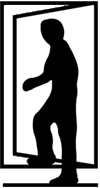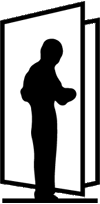How do I hand a door? Well, the first rule to follow when identifying the correct handing is that you must address the door from the outside—also known as the key side, cylinder side or the secured side. Stand on the outside of the door. Determine whether the hinges are on the right or the left. You should be able to make this determination whether the hinges are visible or not. Next, make the following observations to establish the correct handing of the door:
| LEFT HAND When the hinges are on the left (concealed from view) and the door swings away from you (into the room), the door is Left Hand (LH). | RIGHT HAND When the hinges are on the right (concealed from view) and the door swings away from you (into the room), the door is Right Hand (RH). |
| LEFT HAND REVERSE When the hinges are on the left (visible) and the door swings toward you, the door is Left Hand Reverse (LHR). | RIGHT HAND REVERSE When the hinges are on the right (visible) and the door swings toward you, the door is Right Hand Reverse (RHR). |
Handing of a pair of doors can be accomplished one of two ways. If one leaf is held stationary by bolts or some other means, and the other door locks into it, that door with the lock or security device is called the “active leaf.” The stationary door is called the “inactive leaf.” This handing follows the same procedures as shown above for the active leaf and is named and abbreviated accordingly. For example: a pair might be handed as Right Hand Active (RH-Active). Other alternatives would be LH-Active, RHR-Active (RHRA) or LHR-Active (LHRA). When both leaves are operable at all times, the handing is listed to show the swing of both doors. For example: a pair might be 1/Right Hand 1/Left Hand.







